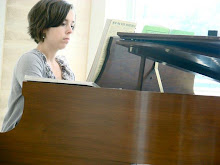One of the greatest pieces of all time. What I love about Chopin's ballades is that they are like fingerprints - no two are alike. Each of them is individual and unique to each person. This is probably just stating the obvious, but I think it's still worth mentioning: all of the ballades begin harmonically ambiguous. They all open in unison (the 3rd a single pitch and all others at the octave). I really enjoy this mystery in the beginning, and the key areas that are established from here on out, some pretty distantly related, are ingenious.
After listening to three anonymous recordings of the first ballade, I have decided that pianist #3 is probably my favorite (followed very closely by #1), and pianist #2 was my least favorite, though not to discredit the merit of his recording. #2 took a much different approach than did #1 and 3, and I found myself enjoying the other two more.
What struck me the most about #1's playing is the beautiful way that he phrased the theme. Rubato, phrasing, sound, etc. - everything was so naturally crafted so as to bring the listeners through every single turn in the melody. Even as momentum picked up in the music, the melody was always present, and the pianist followed every line. This dedication to the melody was present in all sections of the ballade. From the very beginning through climactic sections such as the A major statement, the motion of the music swirls to acknowledge each detail. I do not feel that this detracted from the overall structure of the piece though because #1 knew when to conserve and when to let loose. For example, in the big A major section (which is so fulfilling to play, by the way), he played his heart out. At this point, this was the most significant moment yet, and the preceding sections were all treated in preparation for this glorious statement of the theme. I think that good balance and pacing are maintained throughout with give-and-take measured in appropriate respect to the piece. As for the coda, WTF? I love how aggressive it was, although for me it was a bit too fast. But seriously, good for him. Whoever he is.
The big overall difference in #2's playing is that I think he paid less detailed attention to the smaller sections of the ballade, such as the transitions and the more subdued thematic statements. Much of his playing is rather conservative, in a way so as to "save" himself for where it really counts. In the beginning he really concentrates on the motivic quality of the theme; his playing was weighted to the repetition of that C every time. To me, his rubato and pacing are not as natural as #1. He chose to bring out different notes and different lines, which are effective, but just not as desirable to me. #2 does not let loose as early on as does pianist #1 (for example, the transition immediately following the first presentation of the A theme). While listening and wanting more, I was thinking to myself, "Perhaps he's saving himself for something more to come later?" And this is exactly what he does. Much of his playing strikes me as more straightforward with maybe less attention to detail. To me this is a little unnatural and is less pleasing. One thing that really struck me is the build up to the big A major section. The drastic playing of the rests were a bit strange (or I guess just different), but I really appreciated the tension that was created here. It's like, "Wait for it...wait for it..." and then the A major section arrives. This is where #2 really lets himself go. The entire rest of the piece before this were all in preparation for this moment, which explains the conservative approach in the beginning. #2 is clearly more interested in the overall picture and therefore does not get too carried away in the smaller sections. His playing of the coda actually sounds playful to me somehow. Cool.
#3 was captivating right from the first note. I really like the inflection that he used in the A section - his use of rubato and slight changes in color were very effective. The impression that I got from #3 is that each section of the piece was its own individual scene. He seemed to notice each moment more than pianist #2, and perhaps even more than #1, which created a slower paced approach than the other two. By this I am not referring to tempo. There is still an overall structure in tact though - build up to the significant moments (A major, the B-flat section before the coda) is still achieved. It just seems that a bit more attention is paid to each detail, and this is certainly not a bad thing. #3's playing of the coda was my favorite of all. It was exciting, the pacing of it was good, and he had excellent clarity. Also a live performance - geez!
Sunday, February 10, 2008
Subscribe to:
Comments (Atom)
